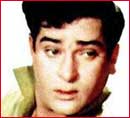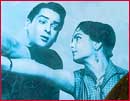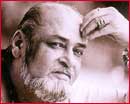Cinema's own Junglee-Janwar-Budtameez!
Raju Bharatan
I habitually referred to him, from viewing his films, as The Junglee-Janwar-Budtameez of the Indian Screen.
 When Bunny Reuben invested him with the label of The Rebel Star, The Revolting Star was my spot printed counter.
When Bunny Reuben invested him with the label of The Rebel Star, The Revolting Star was my spot printed counter.
Yet there was no wishing away Shammi Kapoor as a cult, once he cut through with Tumsa Nahin Dekha.
That was in 1957.
And it was singing-swinging to the beat of O P Nayyar (not Shanker-Jaikishan, as popularly believed) that Shammi Kapoor arrived.
Arrived as the dancing-prancing hero who, preaching a new Athletics of Romance, bent almost every heroine (ranging from the
voluptuous Ameeta to the pencil-thin Saira Banu) to his will.
Wilful like no other hero in our films was Shammi Kapoor -- once he came through. But that breakthrough was a long, long
time in coming. Because Shammi started out, as the leading man, in an age when the hero, in Hindi cinema, would sigh rather
than smile!
And, to sigh, the hero then had, willy-nilly, to sing in the voice of Talat Mahmood.
Shammi gamely tried his hand at this gambit, as Anu's (Malik) father, Sardar Malik, gave him two of the finest Talat renditions
to enact on screen.
One of these was the Majaaz-written Ae gham-e-dil kya karoon (in Thokar), the other was the Shakeel-penned Tere dar pe aaya hoon fariyaad le kar (in Laila Majnu).
How Shammi flopped as 'Majnu' opposite Nutan playing 'Laila' in 1953! No less opposite Suraiya symbolising 'Shama' -- Shammi just was not cut out to be her 'Parwana' -- even though, here, he had the more robust voice of Mohammed Rafi to lend his screen personality greater conviction -- Tu ne mera yaar na milayaa (in Shama Parwana).
 Many happy returns to the era in which he suffered from a severe identity crisis, as a hero, is something Shammi Kapoor might
or might not welcome on this happy day in his life and times.
Many happy returns to the era in which he suffered from a severe identity crisis, as a hero, is something Shammi Kapoor might
or might not welcome on this happy day in his life and times.
But one thing about Shammi is that he has been brutally frank, all along, in appraising himself.
Not until he met Geeta Bali in Coffee House (Is mehfil mein aana bachch ke: Roshan going O P Nayyarish, in 1957, with the
vocal aid of Geeta Dutt), did Shammi realise that he needed a screen metamorphosis, if he was to succeed in hoi-polloi Hindi
cinema.
Geeta Bali remains one of our more underrated actresses. Shammi married Geeta Bali in the face of staunch opposition from
stalwart father Prithviraj and the Kapoor family in general.
Yet Geeta Bali it was who made Shammi divine that there was no hope, for him, so long as he tried to remain the soft romantic
on the silver screen.
If Shammi ever was to make good in this idiom, he would have done so (Geeta Bali pointed out), under a master director like
Mahesh Kaul.
Shammi's Mahesh Kaul film was Jeewan Jyoti (1953) in which he had co-starred with Kardar-Kolynos Contest runner-up Chand Usmani.
While the writing and the direction of Jeewan Jyoti (at Kardar Studios under the banner of Musical Pictures) were entrusted to
Mahesh Kaul, A R Kardar himself, simultaneously, ventured to present Talat Mahmood as a singing star in Dil-e-Nadan --
opposite Peace Kanwal, the young lady who had emerged as the prestigious Kardar-Kolynos Contest winner!
Both Kardar productions bombed with a resonance that vitally affected the careers of Shammi Kapoor and the one in whose
voice they would have Shammi sing those days: Talat Mahmood (though Mohammed Rafi was Kapoor's peripheral playback
in Jeewan Jyoti).
 Mahesh Kaul, as the maker of Raj Kapoor's critically acclaimed Gopinath (1948), enjoyed the rating of a 'genius director' in
Hindi cinema.
Mahesh Kaul, as the maker of Raj Kapoor's critically acclaimed Gopinath (1948), enjoyed the rating of a 'genius director' in
Hindi cinema.
And Geeta Bali's point now was that, if a director of such a high calibre could not 'flesh out' Shammi's personality as a gentle
romantic, clearly her husband was on the wrong road to stardom.
As an extrovert, Shammi needed to 'open out', in tune with his personality, through his films, Geeta noted. And an opportunity
to so differently open out came Shammi Kapoor's way with Filmistan's Tumsa Nahin Dekha.
It was Nasir Husain's first film as a writer-director. Its title (Tumsa Nahin Dekha) had been determined after a 'competition' held among the vast staff of Filmistan.
The film's heroine, Ameeta, was the amply endowed 'personal' property of Filmistan owner Tolaram Jalan. So Tumsa Nahin Dekha (with Ameeta summing up its title) was a film made with the sexy focus on that heroine, a heroine herself still groping for a foothold in the slippery sands of stardom.
That, happily, left Shammi Kapoor to do his own thing in Tumsa Nahin Dekha. And Shammi just let himself go in the capacious company of Ameeta.
Aided, in a big way, by the snappy style in which O P Nayyar composed some very special Rafi tunes to go on Shammi in the
show: Yoon to hum ne laakh haseen dekhe hai tumsa nahin dekha; Jawaaniya yeh mast mast bin piye; Chhup ne waale saamne aa.
Plus those Asha-Rafi, Ameeta-Shammi duets to hum and strum: Dekho qasam se dekho qasam se; Aaye hai door se mil ne hazoor se; and the one to top them all: Sar pe topee laal haath mein resham ka roomal o tera kya kehna.
O P Nayyar is more readily linked with Shammi Kapoor via Kashmir Ki Kali -- the Shakti Samanta colour movie signalling the glamorous aura in which this hero got Sharmila Tagore to make her non-Satyajit Ray-mode bow in Hindi cinema.
Yet it was with O P Nayyar's Tumsa Nahin Dekha, a full seven years earlier, that the dramatic change of screen fortune had come about for Shammi Kapoor.
Until then (1957), Shammi had been a struggler, pure and simple. Nothing, just nothing, he did had come right.
Believe it or not, Sardar Malik's Laila Majnu Talat classic, Tere dar pe aaya hoon fariyaad le kar, was Shammi-bodily repeated, a year later, in Chor Bazar -- with the ultra-saucy Chitra for this Kapoor hero's female foil.
 But it was no go. Shammi Kapoor's screen personality just was not developing. Not even when Salil Chowdhury (arguing that "even Shakespeare copied!") presented The Wedding Samba as the Lata-Hemant Halke halke chalo saanwre (in Tangawali), on Anita Guha and Shammi Kapoor.
But it was no go. Shammi Kapoor's screen personality just was not developing. Not even when Salil Chowdhury (arguing that "even Shakespeare copied!") presented The Wedding Samba as the Lata-Hemant Halke halke chalo saanwre (in Tangawali), on Anita Guha and Shammi Kapoor.
If Lata Mangeshkar refused to sing for O P Nayyar -- and that composer daringly retorted that he never did ask the Melody Queen if she would perform for him! -- it had to be, I suppose, in a Shammi Kapoor disaster movie.
A movie in which Nalini Jaywant was his 1954 Mehbooba.
It was upon Hrithik's granddad Roshan being replaced (midway through) by O P Nayyar in Mehbooba that Lata lost her cool even while O P Nayyar stood up to her like the iceberg.
So Mehbooba is certainly remembered as the film with which the Lata-O P Nayyar 'rift in the lute' first came to the fore.
All the more so as dethroned rival Shamshad Begum created a sensation by publicly announcing that she would sing
for O P Nayyar in Mehbooba at a time when every other voice in films just shied away, fearful of the clout Lata
already wielded in 1954.
But K Amarnath's Mehbooba, if it helped in the ultimate making of O P Nayyar as the wavemaker-composer, certainly
did not advance the cause of Shammi Kapoor as a hero (opposite even the lotus-eyed Nalini Jaywant).
The public here rejected Shammi Kapoor with the same insensitivity, in his salad years, as they were to spurn Amitabh
Bachchan in his beginning times.
To this extent, it could be said that Geeta Bali hid her light under a bushel so that her husband's might shine the brighter. For Geeta Bali instinctively discerned that, so long as an actress of her matchless versatility remained a visible presence on the screen, her husband's career would never flower.
Geeta Bali, while gracefully withdrawing from the scene, asked Shammi not to look back after Tumsa Nahin Dekha -- just to concentrate on his Dil Deke Dekho norm of screen love-making!
Dil Deke Dekho (1959) was S Mukerji's Filmalaya-inaugurating movie -- a movie with which Shammi Kapoor acquired the reputation of being the launching-pad for bouncy new girls.
 Full of bounce opposite Shammi was our present Sushma Swaraj-handpicked censor chief, Asha Parekh, in her maiden
movie (Dil Deke Dekho).
Full of bounce opposite Shammi was our present Sushma Swaraj-handpicked censor chief, Asha Parekh, in her maiden
movie (Dil Deke Dekho).
Dil Deke Dekho also marked the debut of Usha Khanna as that rare thing still in our films: a lady music director. And Usha Khanna's O P Nayyarised compositions, for the Shammi-Rafi team in Dil Deke Dekho, clicked in a big way.
Apart from the title Dil deke dekho dil deke dekho song here, there were, in this Asha Parekh-Shammi Kapoor starrer, Rafi's Bolo bolo kuchch to bolo; Raahee mil gaye raahon mein; and, in a different vein, Hum aur tum aur yeh samaan kya nasha nasha sa hai.
Email Raju Bharatan